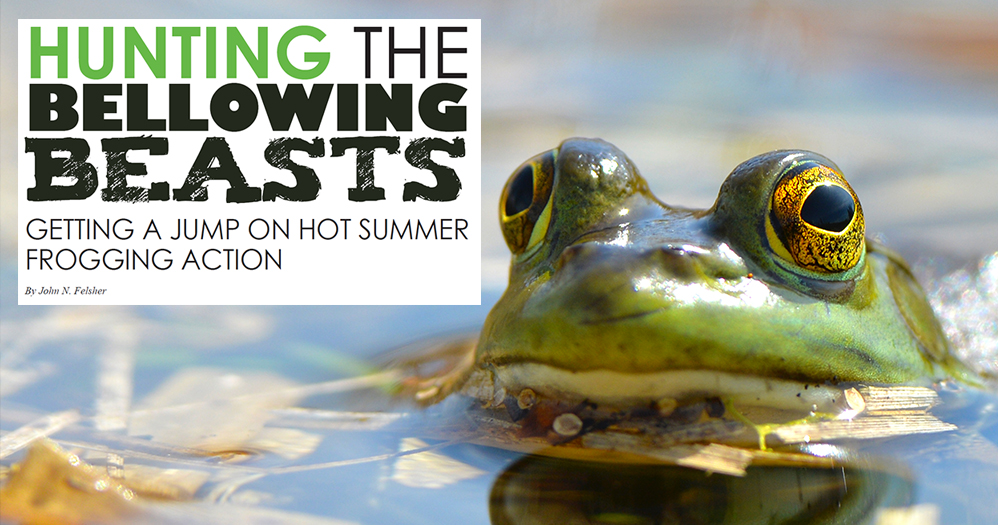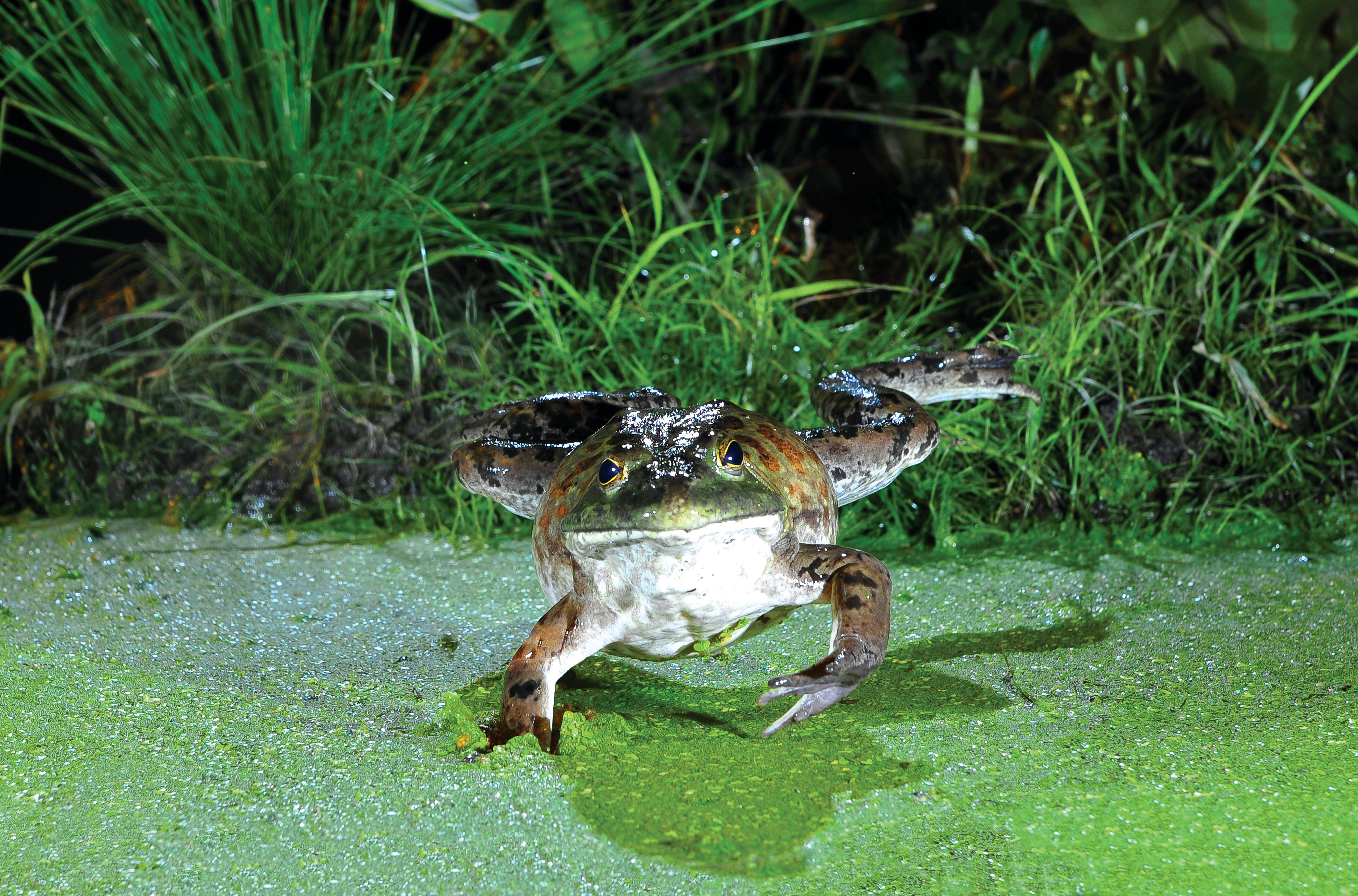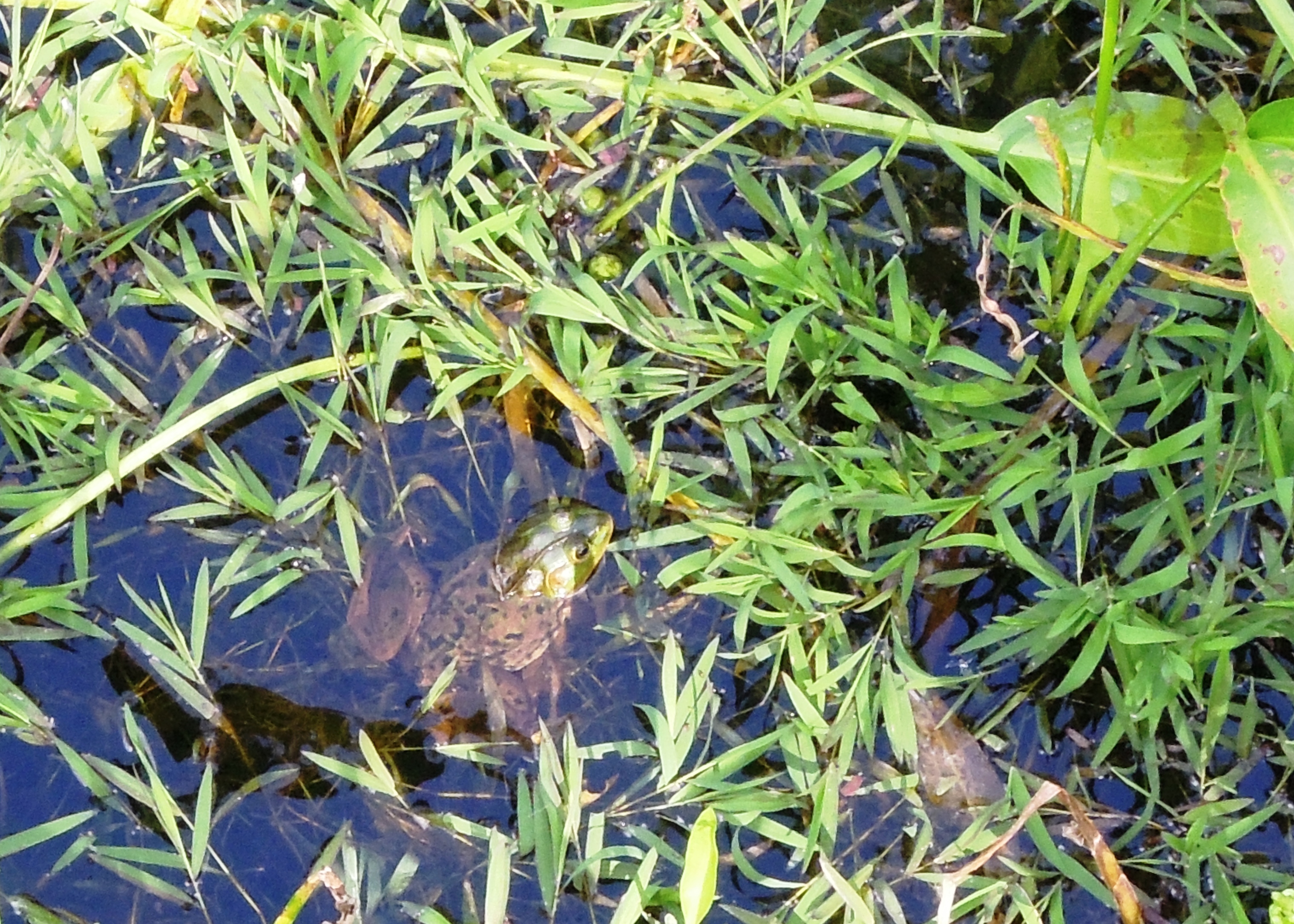Hunting the Bellowing Beasts
6/27/2018 3:21:47 PM
By John N. Flesher

On steamy Southern nights, hunters search forbidding swamps bordering river backwaters looking for hungry predators that can jump 10 times their length and eat anything they can stuff into their cavernous mouths.
In the pallid moonlight, every shadow looms ominously like long-fingered, skeletal monsters reaching across the gripping blackness. Narrow light beams vainly puncture rays through the enshrouding darkness. As the beams hit them, the bony clutching fingers of skeletal hands revert to branches. Occasionally, lights reflect something along a shoreline or a weedy patch where a croaking, bellowing predator lurks.
The tradition of catching frogs on hot summer nights goes back many years in the South. In Mississippi, hunters can catch three frog species from March 31 to Sept. 30 each year with a nightly limit of 25. Most people go for bullfrogs, the biggest of the bunch. A bullfrog can measure up to six inches from nose to tail, but its muscular legs can stretch twice as long as its body.
“Bullfrogs can be found throughout most of the state, but are more likely to be found in the Mississippi Delta and southwestern portions of the state,” said Darrin Hardesty, a biologist with Mississippi Department of Wildlife, Fisheries, and Parks (MDWFP) and a keen frogger (frog hunter). “They live primarily in river systems and tributaries, flooded swamps, catfish ponds, and areas that are managed for moist soil.”

Similar to bullfrogs, pig frogs thrive throughout the southern states from Texas to South Carolina. Some people call them lagoon frogs. Slightly smaller than a bullfrog, a pig frog can grow to about 5.5 inches from nose to tail. During warm nights, this frog bellows like a pig, giving the amphibian its name. The smaller cousin, a bronze frog also looks similar to the others but only grows to about three to four inches from snout to tail. Also found throughout Mississippi, many people confuse it for a juvenile bullfrog or pig frog.
“Pig frogs are found generally from about Hattiesburg south,” said Dr. Robert L. Jones with MDWFP’s Mississippi Museum of Natural Science. “The best way to identify these three species is through their calls. Most people are familiar with the bullfrog call, which has been described as loud, low-pitched, and sounding like ‘jug-o-rum.’ Pig frog calls actually sound like pigs grunting, and bronze frogs make a call that has been described as like a loose string on a banjo, sort of a glunk.”
Most frogs thrive in swamps with abundant weeds, lakes, shallow streams, ponds, marshes and other wet places where they can lay their eggs. They generally turn more active on hot nights when they pick good spots in thick weeds or on a shoreline to wait for morsels to pass irresistibly close. Voracious predators, frogs eat anything they can swallow. The menu could include small fish, insects, lizards, other frogs, crawfish, small mammals, and even birds that venture too close.
Most froggers slowly cruise along lake or stream shorelines on steamy evenings shining powerful lights toward likely hiding spots. When a light beam illuminates a frog sitting on a bank, its white chin and eyes typically shine like two dots hovering over a bright, cottony splotch or a triangle of white dots (two smaller ones above a larger one). Lights temporarily blind or hypnotize frogs, allowing hunters time to sneak up and catch them.
In Mississippi, frogs can be caught in many ways: mechanical grabber, barbed gig, net, air gun, or archery equipment. But it is essential to check the regulations about shooting frogs from boats on public properties before hunting.
“Most Wildlife Management Areas with good habitat would have a good population of frogs, but some only allow hunting of certain species,” Hardesty said. “All other species that are not listed under the individual WMA’s regulations are prohibited from being harvested. Some public lands, such as WMAs and national wildlife refuges, may require other special use permits, so always check the regulations for each individual property before going frogging anywhere.”
Some people choose to catch frogs by hand. They sneak close to them and grab them. A cautionary note, many other creatures might also enjoy snatching a delectable amphibian to eat. Before grabbing a frog by hand, look carefully around the general vicinity for alligators, venomous snakes, snapping turtles, and other predators also looking for a meal.
“I go at night mostly and shine a spotlight to find them,” Hardesty said. “Once I locate them, I prefer to hand-grab them, without a gig or clamp. It is more of a challenge that way. Most people would presumably use a long pole with a fishing gig, a small net or a grabber-style attachment. Without a doubt, you can be much more successful with a gig. I have also been successful in catching bullfrogs during the middle of the day, using only a crappie pole and a small treble hook.”
Hunters do not need to chase amphibians in the big waters or even use a boat. Frogs can live in the smallest habitat, as long as it remains reasonably wet with some access to dry ground or structure and sufficient food. Canals and small drainage ditches can provide an outstanding frog habitat with little pressure from other froggers. For people without boats, small streams meandering through forests or isolated ponds can concentrate numerous frogs in otherwise dry areas, providing excellent hunting grounds for froggers.
As a boy, I frequently walked along roadside drainage ditches near my home. Some barely held more than a few inches of water or even went dry for part of the year. Frogs typically can congregate in slightly deeper pools, such as near the mouth of a culvert. Sometimes, I’d “cane-pole” for bullfrogs in small ditches, which required considerable craftiness and often teamwork. During the day, I’d try to sneak up behind a frog sitting in a ditch and use a cane pole and fishing line to dangle a piece of red cloth attached to a small panfish hook in front of a croaker. Thinking that it spotted a juicy insect, it fired out its lethal tongue and brought back a catch.

At night, we often worked in teams. When we spotted a frog, one person with a cane pole rig stealthily came from behind the squatting beast. The other remained close enough for the frog to see and hold its attention, but far enough away to avoid spooking the amphibian. That person shined a light toward the frog to illuminate it, but not directly into its eyes so it could still see and snatch the red cloth. Of course, people can also use actual bait, such as a worm, cricket, or moth, dangled in the same manner.
After catching frogs, drop them into a securely tied sack, locking ice chest or another container. With powerful legs, bullfrogs can jump long distances and can knock the top off an unlocked ice chest. A Southern delicacy, fried frog legs covered in spices taste so delicious that many restaurants serve them.
“Not only are frogs fun to catch, but they are also excellent table fare,” Hardesty said. “I prefer them fried, but I have also sautéed them. Both ways will not disappoint.”
John N. Felsher is a freelance writer for Mississippi Outdoors









